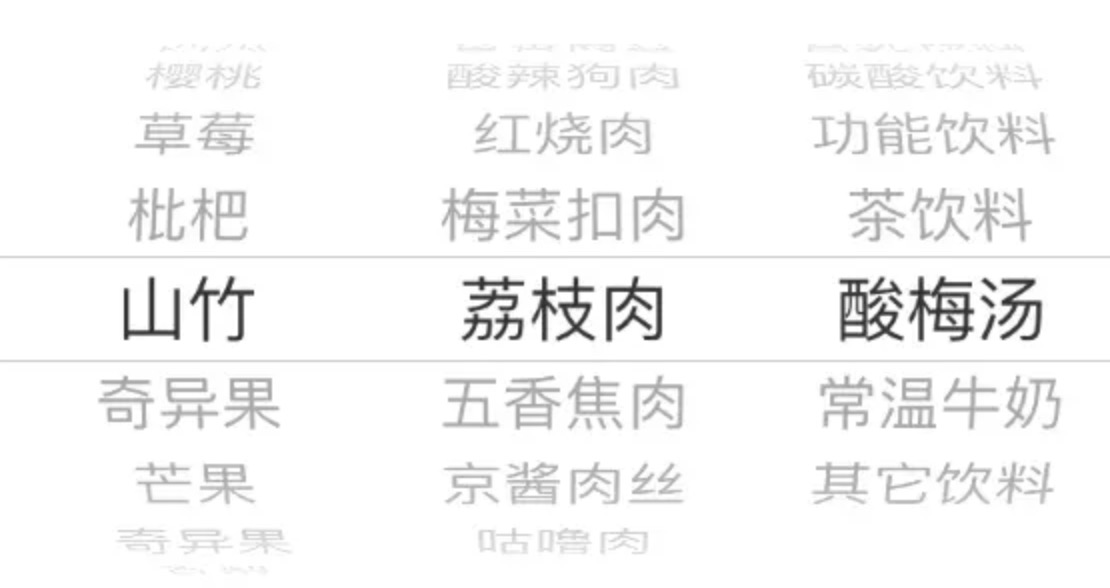1
2
3
4
5
6
7
8
9
10
11
12
13
14
15
16
17
18
19
20
21
22
23
24
25
26
27
28
29
30
31
32
33
34
35
36
37
38
39
40
41
42
43
44
45
46
47
48
49
50
51
52
53
54
55
56
57
58
59
60
61
62
63
64
65
66
67
68
69
70
71
72
73
74
75
76
77
78
79
80
81
82
83
84
85
86
87
88
89
90
91
92
93
94
95
96
97
98
99
100
101
102
103
104
105
106
107
108
109
110
111
112
113
114
115
116
117
118
119
120
121
122
123
124
125
126
127
128
129
130
131
132
133
134
135
136
137
138
139
140
141
142
143
144
145
146
147
148
149
150
151
152
153
154
155
156
157
158
159
160
161
162
163
164
165
166
167
168
169
170
171
172
173
174
175
176
177
178
179
180
181
182
183
184
185
186
187
188
189
190
191
192
193
194
195
196
197
198
199
200
201
202
203
204
205
206
207
208
209
210
211
212
213
214
215
216
217
218
219
220
221
222
223
224
|
public interface PickerAdapter {
@LayoutRes int getItemLayoutResource();
int getItemCount();
String getItemAt(int pos);
}
public class PickerView extends FrameLayout {
private ListView listView;
private int visibleCount = 5;
private float itemHeight;
Paint dividerLinePaint;
Paint greyLayerPaint;
PickerAdapter adapter;
private float dividerThickness;
private float dividerMarginLeft;
private float dividerMarginRight;
private float velocityThreshold;
private VelocityTracker velocityTracker = VelocityTracker.obtain();
public PickerView(@NonNull Context context) {
this(context, null);
}
public PickerView(@NonNull Context context, @Nullable AttributeSet attrs) {
this(context, attrs, 0);
}
public PickerView(@NonNull Context context, @Nullable AttributeSet attrs, final int defStyleAttr) {
super(context, attrs, defStyleAttr);
setWillNotDraw(false);
itemHeight = getResources().getDimension(R.dimen.picker_view_item_height);
velocityThreshold = getResources().getDisplayMetrics().density * 260;
TypedArray ta = context.obtainStyledAttributes(attrs, R.styleable.PickerView);
dividerThickness = ta.getDimension(R.styleable.PickerView_divider_thickness, getResources().getDisplayMetrics().density);
dividerMarginLeft = ta.getDimension(R.styleable.PickerView_divider_margin_left, 0);
dividerMarginRight = ta.getDimension(R.styleable.PickerView_divider_margin_right, 0);
int dividerColor = ta.getColor(R.styleable.PickerView_divider_color, Color.LTGRAY);
ta.recycle();
dividerLinePaint = new Paint();
dividerLinePaint.setColor(dividerColor);
dividerLinePaint.setStyle(Paint.Style.STROKE);
dividerLinePaint.setStrokeWidth(dividerThickness);
greyLayerPaint = new Paint();
greyLayerPaint.setColor(0xb0ffffff);
}
public void setAdapter(PickerAdapter adapter) {
setAdapter(adapter, 0, 0);
}
public void setAdapter(PickerAdapter adapter, int initPos) {
setAdapter(adapter, 0, initPos);
}
public void setAdapter(PickerAdapter adapter, int visibleCount, int initPos) {
if (adapter.getItemCount() <= 0) {
return;
}
if (visibleCount > 0 && visibleCount % 2 != 0) {
this.visibleCount = visibleCount;
}
this.adapter = adapter;
listView = new ListView(getContext());
addView(listView, new LinearLayout.LayoutParams(ViewGroup.LayoutParams.MATCH_PARENT, (int) (itemHeight * this.visibleCount)));
listView.setOverScrollMode(View.OVER_SCROLL_NEVER);
listView.setVerticalScrollBarEnabled(false);
listView.setDivider(null);
listView.setOnScrollListener(new AbsListView.OnScrollListener() {
@Override
public void onScrollStateChanged(AbsListView view, int scrollState) {
if (scrollState == AbsListView.OnScrollListener.SCROLL_STATE_IDLE) {
scrollToNearest();
}
}
@Override
public void onScroll(AbsListView view, int firstVisibleItem, int visibleItemCount, int totalItemCount) { }
});
listView.setAdapter(new InnerAdapter());
if (initPos > 0 && initPos < adapter.getItemCount()) {
listView.setSelection(initPos);
}
}
public int getSelectedPosition() {
listView.getFirstVisiblePosition();
View firstChild = listView.getChildAt(0);
if (Math.abs(firstChild.getTop()) < firstChild.getHeight() / 10) {
return listView.getFirstVisiblePosition();
} else {
return listView.getFirstVisiblePosition() + 1;
}
}
@Override
public boolean dispatchTouchEvent(MotionEvent ev) {
boolean superResult = super.dispatchTouchEvent(ev);
velocityTracker.addMovement(ev);
if (ev.getActionMasked() == MotionEvent.ACTION_UP) {
velocityTracker.computeCurrentVelocity(1000);
float yVelocity = velocityTracker.getYVelocity();
if (Math.abs(yVelocity) < velocityThreshold) {
scrollToNearest();
}
}
return superResult;
}
private void scrollToNearest() {
View firstChild = listView.getChildAt(0);
if (Math.abs(firstChild.getTop()) > Math.abs(firstChild.getBottom())) {
listView.smoothScrollToPosition(listView.getLastVisiblePosition());
} else {
listView.smoothScrollToPosition(listView.getFirstVisiblePosition());
}
}
@Override
protected void onDetachedFromWindow() {
velocityTracker.recycle();
super.onDetachedFromWindow();
}
@Override
public void draw(Canvas canvas) {
super.draw(canvas);
canvas.drawLine(dividerMarginLeft, itemHeight * 2 - dividerThickness,
getWidth() - dividerMarginRight, itemHeight * 2 - dividerThickness, dividerLinePaint);
canvas.drawLine(dividerMarginLeft, itemHeight * 3 + dividerThickness,
getWidth() - dividerMarginRight, itemHeight * 3 + dividerThickness, dividerLinePaint);
canvas.drawRect(0, 0, getWidth(), itemHeight * 2 - dividerThickness, greyLayerPaint);
canvas.drawRect(0, getHeight() - 2 * itemHeight + dividerThickness, getWidth(), getBottom(), greyLayerPaint);
}
private class InnerAdapter extends BaseAdapter {
@Override
public int getCount() {
return adapter.getItemCount() + visibleCount - 1;
}
@Override
public Object getItem(int position) {
if (position < visibleCount / 2 || position >= getCount() - visibleCount / 2) {
return "";
}
return adapter.getItemAt(position - visibleCount / 2);
}
@Override
public long getItemId(int position) {
return position;
}
@Override
public View getView(final int position, View convertView, ViewGroup parent) {
if (convertView == null) {
convertView = View.inflate(getContext(), adapter.getItemLayoutResource(), null);
convertView.setBackgroundColor(Color.WHITE);
}
convertView.setOnClickListener(new OnClickListener() {
@Override
public void onClick(View v) {
int cur = getSelectedPosition() + visibleCount / 2;
if (position > cur) {
listView.smoothScrollToPosition(position + visibleCount / 2);
} else if (position < cur) {
listView.smoothScrollToPosition(position - visibleCount / 2);
}
}
});
TextView textView = convertView.findViewById(R.id.picker_text_view);
textView.setText((String) getItem(position));
return convertView;
}
}
}
|
